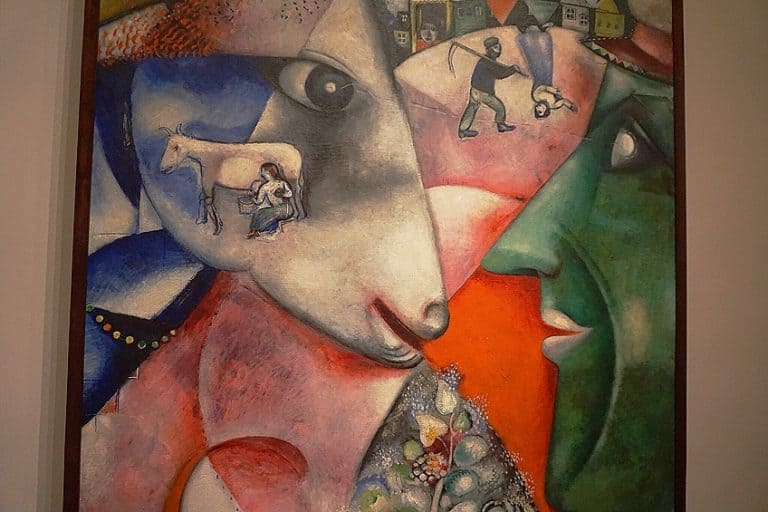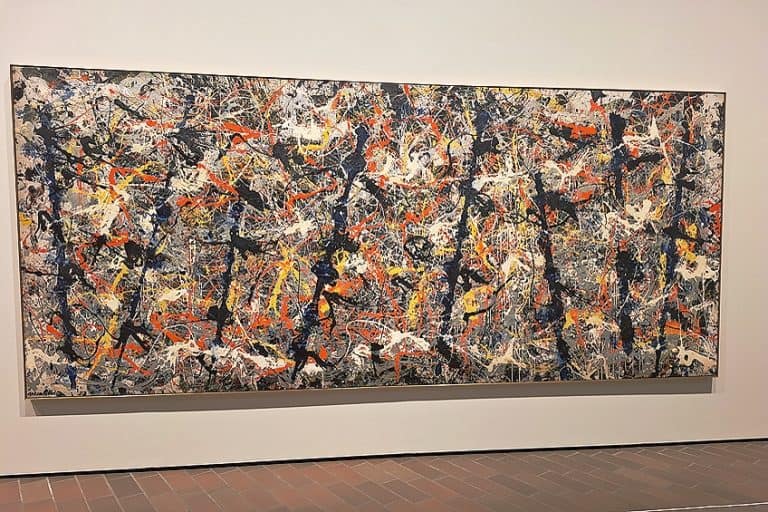Botticelli Paintings – The Most Famous Works of Sandro Botticelli
Sandro Botticelli was considered the most important Humanist artist of his era. His artworks are said to represent the apex of the rising Florentine culture. His work also featured in famous religious buildings such as the Sistine Chapel. Botticelli’s oeuvre not only covered religious themes but also mythological topics and characters. Today his artworks can be viewed in many famous international museums and galleries.
A Look at Important Sandro Botticelli Paintings
Botticelli, the child of a tanner, was intelligent above his age and easily distracted in classes. He was noted for his keen humor and fondness of gags, and he rapidly gained a reputation for being a frenetic, restless, and impatient youngster.
Thankfully, his early potential was recognized, and he was removed from schooling and assigned to work in an apprenticeship.
Sandro Botticelli was at his most inventive between 1478 and 1490. This was the time when he created his well-known mythological masterpieces. In these, he effectively blended ornamental line work with classical styles, as seen by the balance of his arrangement and the fluid curves of his models. Botticelli’s art seemed to suffer through a stylistic and expressive dilemma in the final 15 years of his existence.

The 1490s were a tumultuous decade in which the Medici were ousted from Florence and Italy’s tranquility was shattered by invaders and epidemics. Botticelli abandoned the decorative appeal of his early works in favor of a more straightforward technique that appeared vulgar and heavy-handed in comparison.
These latter works, with their significant ethical and theological implications, were also compared to the refined aesthetics of painters like Raphael and Michelangelo.
Allegory of Fortitude (1470)
| Date Completed | 1470 |
| Medium | Tempera |
| Dimensions | 167 cm x 87 cm |
| Currently Housed | The Uffizi Museum |
This painting is the sole one produced by Sandro Botticelli in a series of artworks dedicated to the Virtues that Piero del Pollaiolo requested in 1469. The sequence was created for the Tribunal Hall in Florence’s Piazza Della Signoria and is currently housed at the Uffizi Galleries. Fortitude is depicted as a young lady dressed in armor and clutching a leader’s amulet.
Despite its militaristic connotations, Virtue refers to power and tenacity in the quest for virtue. She is among the four principles or the four most important human qualities.
Botticelli’s contract was made possible by Tommaso Soderini, one of the employees chosen to supervise the job’s completion, as a result of Botticelli’s connections with the Medici clan, of which Soderini was also a member. Pollaiolo’s excusable outrage helped contribute to Botticelli’s involvement in the commission being limited to this single individual.

Unlike some of the other paintings in the series, which are created on cypress wood, the Fortitude was produced on poplar, a wood that is more typically used for paint on panels in Tuscany. Botticelli’s Virtue is especially notable for its unique marble seat, which features deeper carved embellishments.
The youthful female’s physique is slender and fluid, and her head clearly bears the dreamy, sad look that distinguishes Botticelli’s women characters. The Tribunale di Mercanzia was the organization in charge of resolving conflicts between Florentine traders and administering justice among the unions known as Arts.
The riches and history of this court passed to the Chamber of Commerce, which included the paintings of the Virtues, which were moved to the Uffizi Galleries in 1777.
Portrait of a Man with a Medal of Cosimo the Elder (1475)
| Date Completed | 1475 |
| Medium | Tempera |
| Dimensions | 57 cm x 44 cm |
| Currently Housed | Uffizi Museum |
This portrait was produced in 1575. By this time, Botticelli’s technique, inspired by Pollaiolo, has grown more exact, expressing a taut inquietude of mood through the harmony of the curve. One of the most unique Botticelli portraits of the Early Renaissance is of an unnamed young person.
The man is looking at the viewer and carrying a medallion with the image of Cosimo de Medici’s face, who perished in 1464. Botticelli included the medallion as a golden plaster cast within the artwork.
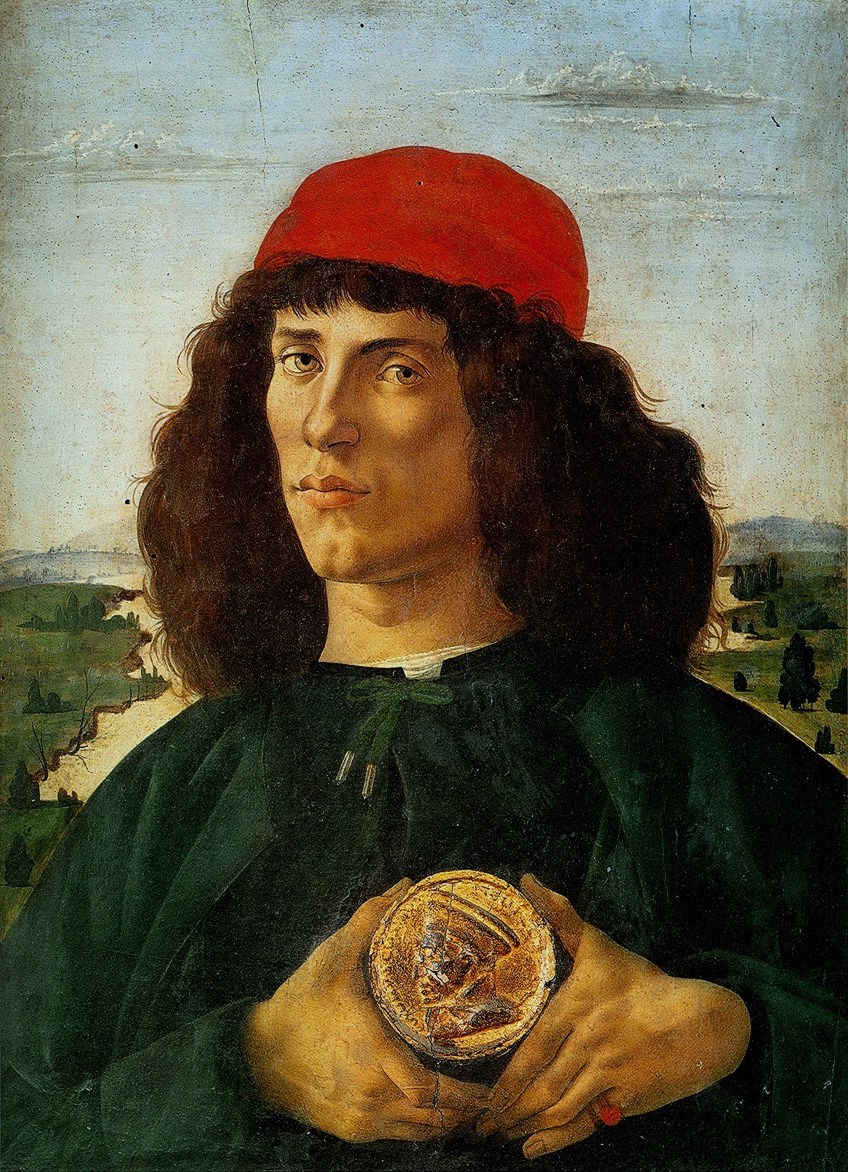
The artwork is a half-length profile of a person before a large light environment with a riverbank, with the man’s head protruding beyond the skyline. The lighting from the left forms the sitter’s remarkable features, and there are darker shadows on the face’s side closest to the viewer.
The poor design of his hands emphasizes the portrait’s exploratory nature. It is one of the first Italian portraits that include the hands as part of the topic.
The Cosimo memorial medal, which dates from around 1470, has sparked a slew of theories regarding the identity of the individual represented. So yet, no conclusive answer has been provided to the issue of whether he is a close cousin or follower of the Medicis, or possibly the individual who designed the medallion. Produced with tempera on panel, the painting is now housed at the Galleria Degli Uffizi in Florence.
Adoration of the Magi (1476)
| Date Completed | 1476 |
| Medium | Tempera |
| Dimensions | 111 cm x 134 cm |
| Currently Housed | Uffizi Gallery |
The Adoration of the Magi is a classic scenario portrayed by Botticelli in which the three Magi, or rulers, bring presents of gold, incense, and frankincense to place before a christ Child. Botticelli’s rendition originates from approximately 1475, and it was a favorite topic among Renaissance artists. Botticelli’s artwork was ordered by an Italian banker, Gaspare di Zanobi del Lama. He desired the artwork for a church in Florence.
The church where the “Adoration of the Magi” originally stood has been demolished, and the picture is currently housed at Florence’s Uffizi, a well-known art museum.

There are a number of people encircling the improvised building where Christ sleeps in this representation of the Adoration of the Magi. When compared to the expensive garments worn by people around the improvised altar, the collapsing structure surrounding Christ represents Jesus’ humble beginnings. The individuals encircling Christ are considered to be modeled on members of the Medici family, as di Zanobi del Lama was a member of the Medici family.
Cosimo de Medici and his sons Piero and Giovanni, as well as Cosimo’s grandchildren Lorenzo and Giuliano, are depicted in the picture. As a result, the Medici are portrayed as the Magi.
All of the individuals in the picture have various stances, attitudes, and personalities, resulting in a painting with a wide range of colors and images. Botticelli is also supposed to have included a self-portrait into the scene; he is said to be the blonde-haired man on the far right. The picture is well-known for its meticulousness. It is believed to have been informed by the Flemish style, which Botticelli was researching at the point he produced it. This famous artwork was a watershed event in his career.
Madonna of the Magnificat (1481)
| Date Completed | 1481 |
| Medium | Tempera |
| Dimensions | 118 cm x 119 cm |
| Currently Housed | Uffizi Museum |
Botticelli painted Madonna of the Magnificat in 1481. The Holy Mother, Mary, is seen in the picture cradling Jesus as a newborn while penning in a book, as two men, perhaps heavenly beings, raise a wreath above her temple. Mary stares solemnly at Christ and the cosmos, anticipating what is to come. The mood of this spiritual painting can be attributed to the era and region in which it was made. Enthusiastic Christianity was heavily stressed during the Renaissance, particularly during the early era; it is also true that a vast majority of Italians follow Catholicism.
The level of theological tension and the sort of atmosphere depicted by the Church in Botticelli’s time helps offer comprehension of the artwork’s actual significance.
Based on the quality of Botticelli’s works he was invited by Pope Sixtus IV at the time of the production of the Madonna of the Magnificat to contribute to the design of artworks used to adorn the Sistine Chapel. This aspect also serves to offer indications as to the true significance of the artwork because, at the time, he was affected by the Pope, who may have forced his own views onto Sandro in order for him to make a specific style of holy art.

Jesus is represented as a newborn in Mary’s arms, his mother’s eyes fixed in a reciprocal, adoring look. A halved pomegranate, also held by baby Jesus’ left hand, is in Mary’s hand, symbolizing Jesus’ later hardship and redemption. Jesus places his right hand on the volume Mary is writing in, as if to signify that he is monitoring its development; guaranteeing that it is a precious verse of the Bible that Jesus recognizes and respects. To fit the humble mood of the work, Jesus, like others who carry Mary’s crown, is clothed in white, with an infant-like blanket concealing his genitalia.
The fact that Jesus and those holding the wreath are clad in white suggests that they are the “celestial” creatures of the image, or rather those who aren’t humans but divine.
La Primavera (c. 1482)
| Date Completed | 1482 |
| Medium | Tempera |
| Dimensions | 203 cm x 314 cm |
| Currently Housed | Uffizi Gallery, Florence |
Botticelli’s famous Primavera artwork, which translates as “Spring,” is one of the most important paintings in the Uffizi Museum in Florence. The painting’s exact significance is uncertain, although it was most likely produced for Lorenzo di Pierfrancesco’s marriage in May 1482. The image depicts a gathering of people in an orange orchard. One of the first things to notice is how little viewpoint is employed; while some environmental context can be seen via the bushes to the sides, we don’t see the linear perspective that many of the Renaissance Era artists used so well in the 15th century.
Also, notice how the limbs of the majority of the models are elongated and narrow, giving them an attractive appearance.
Botticelli created art at a period when there was a market for it at the court of Florence. While the artwork’s actual significance is unknown, we do recognize the identity of several of the individuals depicted in it.
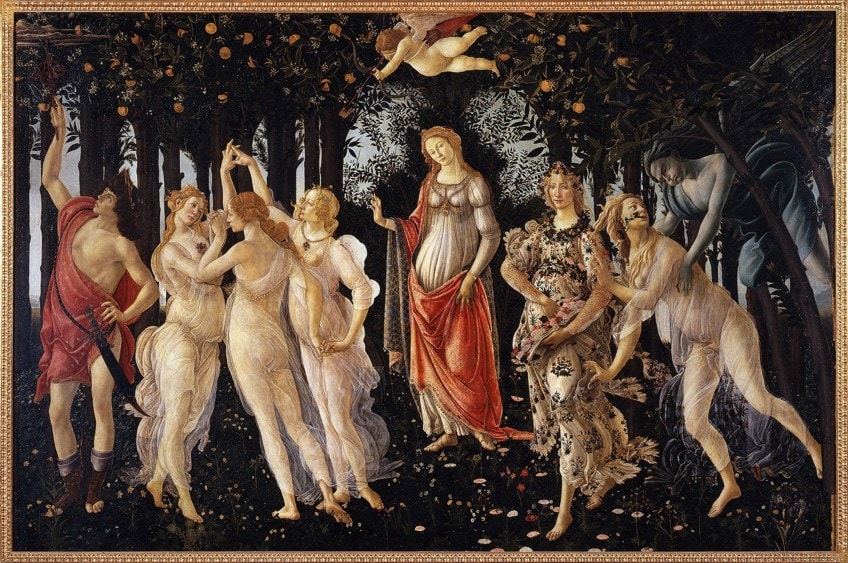
Venus, the Roman deity, is shown in the middle. Her appearance reflects the widespread humanistic fascination in the classical era in Florence at that moment. She is shown as an immaculate figure, somewhat off-center, her head inclined and gesticulating to the right. Positioned behind her is a blinded cherub (her child), and behind him, the tree branches form an archway that frames Venus and gives her a prominent place in the picture.
Mercury, the deity of the month of May, is holding a rod, something he might be employing to chase away the wintry storms. His distinctive winged footwear makes him easily recognizable. The Three Graces are a significant group positioned to Mercury’s right. Botticelli based these figures, who seem to be engaged in some sort of performance, on an old representation of the Three Graces.
These characters are significant because they embody the feminine qualities of modesty, attractiveness, and affection, all of which lead to passion and offer perspective for what is happening in Botticelli’s famous “Primavera” art.
The Trial of Moses (1482)
| Date Completed | 1482 |
| Medium | Fresco |
| Dimensions | 348 cm x 558 cm |
| Currently Housed | Sistine Chapel |
Botticelli traveled to Rome in 1480 with other great Florentine painters as part of a reunification attempt between Pope Sixtus IV and Lorenzo de Medici. The Florentine artists were tasked with decorating the freshly built Sistine Chapel walls with frescoes. One of the topics of the frescos was a connection between Moses’ and Christ’s stories. It represented a link between the Old and New Testaments. Botticelli’s Trials of Moses is a fresco that was completed in the Sistine Chapel between 1481 and 1482.
The painting depicts four incidents from Moses’ lifetime, derived from the book of Exodus.

Firstly, Moses is portrayed on the side, murdering an Egyptian who was tormenting an Israelite before escaping to the wilderness. Moses may be identified in the images by his yellow clothing and green robe. The herders who were blocking Jethro’s girls, notably his future bride, Zipporah, from refreshing their flock at the wellpoint are defeated in the following episode.
He can also be seen in this segment taking water from the wellpoint to assist in watering the herd.
In the next scenario, in the upper left corner, Moses takes off his sandals and obtains the holy mission to travel to Egypt and rescue his tribe, the Israelites. In the last segment, Moses is depicted bringing the Israelites to the Promised Land on the lower-left side. He features seven times in this painting.
Venus and Mars (1483)
| Date Completed | 1483 |
| Medium | Tempera |
| Dimensions | 69 cm x 173 cm |
| Currently Housed | National Gallery, United Kingdom |
Venus, the Roman deity of love, had several suitors, including Mars, the Roman deity of battle. Mars is shown sleeping in the artwork, probably tired after his copulation with Venus. Venus, on the other hand, is fully alert, probably reveling in her triumph. Mars has stripped down to his underwear and many young satyrs are toying with his gear. The picture is a metaphor with several levels of significance and connotation.
Satyrs were Greek mythological beings noted for their lustfulness and mischief. They were supposed to live in the forests and fields and to practice Dionysus’ passionate worship.
The viewer observing this artwork would have understood what the satyrs represented. The satyr in the bottom right of the artwork has piqued the interest of art historians due to the unusual fruit in his hand. Art experts have proposed that this is Datura stramonium, a psychedelic commonly known as Jimsonweed, and that Mars is in fact dozing off.

The species is certainly datura, according to specialists at London’s Kew Gardens. The meaning and importance of this, however, is still being debated. Because the fruit in the Scriptures is not referred to as an apple, there may be a theological allusion here, with an effort to recall the viewer of Adam and Eve – observe that Venus is conservatively clad.
The crucial thing is that, like many artworks, this one has several meanings and may be interpreted in a variety of ways.
The satyr in the lower right corner of the image is within a piece of Mars’ equipment – the breastplate. God’s spear is in the center of the image, producing a sharp line across it, with a headpiece at the tip – all erotic references to imply that Mars is disabled and vanquished by love.
Idealized Portrait of a Lady (1485)
| Date Completed | 1485 |
| Medium | Tempera |
| Dimensions | 82 cm x 54 cm |
| Currently Housed | Städel Museum |
This is regarded as one of the best Botticelli portraits and is assumed to be Simonetta Vespucci. Most thought she was the most attractive woman in Florence at the time. She would subsequently serve Giuliano de’ Medici, one of the greatest supporters of the arts and a descendant of the illustrious de‘ Medici family. Her look is extremely stylized and expensive, which is quite intriguing. Even by the criteria of Florence in the 15th century, the appearance of streamers, plumes, and what looks to be a wig is regarded to be extremely ornate and implausible.
This raises some interesting issues about Botticelli’s sentiments for Vespucci.
Sandro Botticelli never wedded, which some attribute to his forbidden infatuation for Simonetta Vespucci. He had also requested that when he perished, he be buried at the base of her tomb. Tragically, she died at the age of 23, and she would have probably been the topic of many additional Botticelli masterpieces. He passed away at the age of 64.

The artist is recognized for his use of flowing lines, as seen in other Botticelli works such as The Birth of Venus. This later influenced other artists during the Renaissance era. Unique amongst Botticelli portraits, this painting, on the other hand, shows a small deviation.
He appears to have chosen a dark backdrop to express the sitter’s elegance and perhaps imperial character. This was a significant shift for the artist, as the bulk of his previous paintings featured elaborate backgrounds and environments. The impact of blackness, however, was that the exquisite shapes and characteristics of the female stood out far more to the viewer.
We should also observe her raised mouth and a torso that partially confronts the spectator imply that she is very much living rather than a simple model for the painting; maybe this was Botticelli’s goal right from the beginning.
The Birth of Venus (c. 1485)
| Date Completed | c. 1485 |
| Medium | Tempera |
| Dimensions | 172 cm x 278 cm |
| Currently Housed | Galleria Degli Uffizi |
The Birth of Venus is regarded as one of the Renaissance period’s most prized artworks. It depicts the deity Venus emerging from the water on a conch, which corresponds to the narrative that recounts her origin. Her seashell is driven to the shoreline by gusts created by the wind-deities in the midst of a downpour of flowers. As Venus approaches the coast, a Sprite stretches out to shelter her with a shawl. Venus is shown as an attractive and virtuous deity, as well as a sign of the impending springtime.
Her portrayal as a naked woman is important in itself, considering that at this period in the Renaissance period, nearly all artworks were of a religious subject, and nude females were rarely depicted.

Many parts of Botticelli’s Birth of Venus are in movement. For example, the foliage of trees in the backdrop, tresses of hair swept by the Zephyrs, flowers drifting around her, surf softly lapping, and the characters’ robes and draperies swept and carried by the wind. Venus’s stance is evocative of the Venus de Medici, a Classic period marble statue and gemstone engraving in the Medici collections that Botticelli had the chance to examine.
This masterpiece was the very first large-scale canvas produced in the Florentine Renaissance.
In a unique method for his time, he made his own tempera colors with little fats and coated them with a coating of pure egg white. In its vibrancy and luminosity, his work recalls a mural. It has been very well kept, and the paintwork is still flexible, with few flaws. The elegance of Botticelli’s lines is essential to the birth of Venus. The ratios are the most exaggerated, but still, the long neck and stream of hair contribute to the mysterious physique.
Mystic Nativity (1501)
| Date Completed | 1501 |
| Medium | Oil on Canvas |
| Dimensions | 105 cm x 75 cm |
| Currently Housed | National Gallery, London |
This artwork, commonly known as the Mystic Nativity, is the only one that Botticelli signed. This picture depicts the narrative of Jesus’ birth as well as his apocalyptic return to Earth. The term “mystic” appears in the title of this artwork because the portions of the picture related to the rapture are predictive and represent an enigma. The term “mystic” is sometimes used to describe extraordinary artworks with enigmatic and metaphorical significance.
Another instance is Botticelli’s Mystic Crucifixion, which is housed in the Fogg Art Museum in Boston.
The imps at the base of the picture represent Satan’s downfall. The tiny size of the imps in this artwork is yet another sign of Satan’s downfall. Botticelli, on the other hand, shows Mary as extraordinarily big to emphasize her prominence. The olive shoots carried by the angels and growing out of the earth in the foreground foretell the harmony that will follow Christ’s return home. The barn is situated in front of two big boulders, which serve as an example of Jesus’ death and entombment in a cave. The band of angels at the top represents peace.
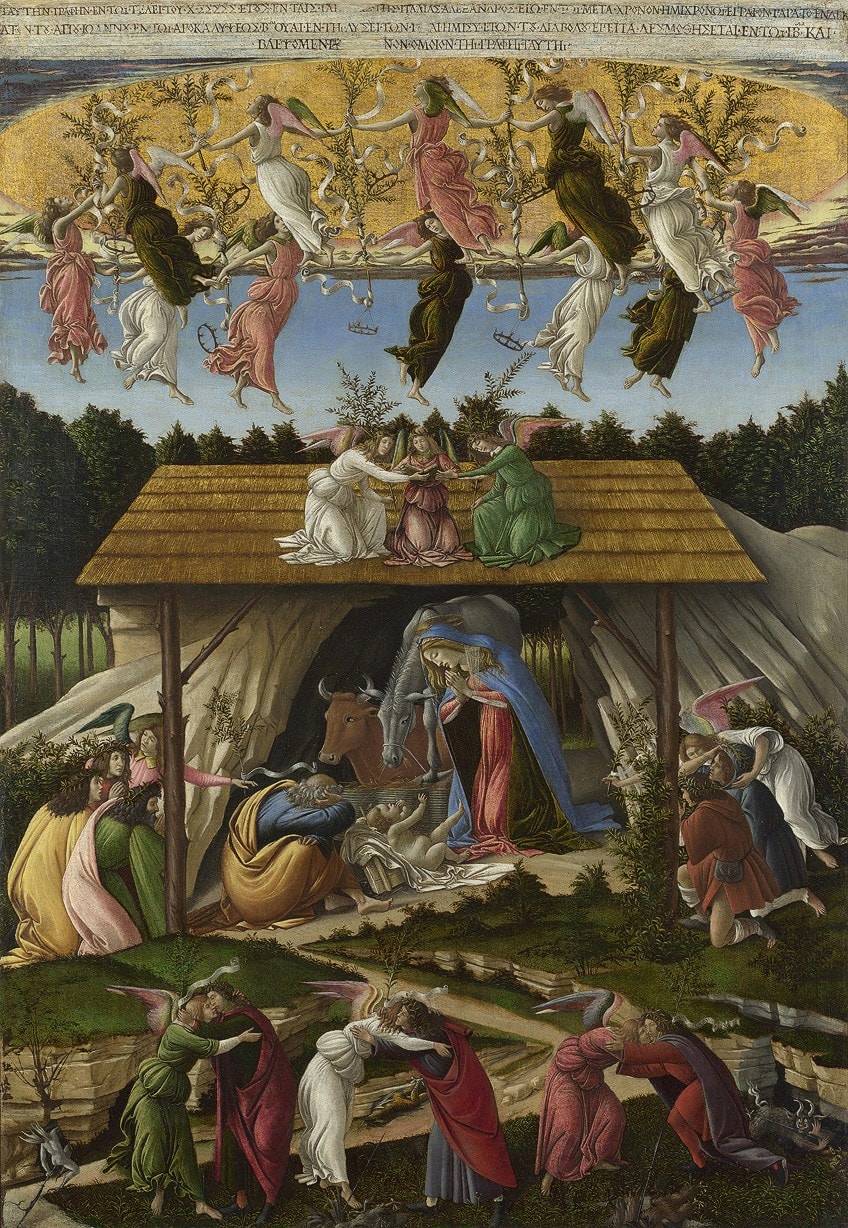
Botticelli predicted that the apocalypse prophesied in the Scriptures will occur in 1504. He was certain that he existed during the Rapture, a brief period of time during which the globe would be subjected to calamity and tragedy. He predicted that the Millennium, a thousand-year era during which Christ will complete the journey, would begin in three and a half years. Botticelli’s conviction was founded in part on the many conflicts at the period, as well as the execution of the Florentine preacher Savonarola, of whom Botticelli was a devotee, two years previously.
And that wraps up our list of important Sandro Botticelli paintings. These famous Botticelli works are all renowned for their important contribution to Renaissance-era art. Botticelli portraits and religious paintings continue to reveal more layers of symbolism as time goes on. By observing his unique attention to detail and representation of figures, it is easy to see why he was regarded as the most important artist of his era.
Frequently Asked Questions
What Are Some of the Most Important Botticelli Paintings?
Botticelli has left behind a fine legacy of artworks. His Primavera artwork, Venus and Mars, as well as the Birth of Venus, are all regarded as important artworks by Botticelli. There are many more though, as he was a very prolific artist.
Why Were Sandro Botticelli Paintings Famous?
He was regarded as the most outstanding Humanist artist of his era. His artworks are said to represent the pinnacle of the burgeoning Florentine culture. His work also featured in famous religious buildings such as the Sistine Chapel. His artwork not only covered religious themes but also mythological topics and characters. Today, his artworks can be viewed in many famous international museums and galleries.
Isabella studied at the University of Cape Town in South Africa and graduated with a Bachelor of Arts majoring in English Literature & Language and Psychology. Throughout her undergraduate years, she took Art History as an additional subject and absolutely loved it. Building on from her art history knowledge that began in high school, art has always been a particular area of fascination for her. From learning about artworks previously unknown to her, or sharpening her existing understanding of specific works, the ability to continue learning within this interesting sphere excites her greatly.
Her focal points of interest in art history encompass profiling specific artists and art movements, as it is these areas where she is able to really dig deep into the rich narrative of the art world. Additionally, she particularly enjoys exploring the different artistic styles of the 20th century, as well as the important impact that female artists have had on the development of art history.
Learn more about Isabella Meyer and the Art in Context Team.
Cite this Article
Isabella, Meyer, “Botticelli Paintings – The Most Famous Works of Sandro Botticelli.” Art in Context. October 15, 2021. URL: https://artincontext.org/botticelli-paintings/
Meyer, I. (2021, 15 October). Botticelli Paintings – The Most Famous Works of Sandro Botticelli. Art in Context. https://artincontext.org/botticelli-paintings/
Meyer, Isabella. “Botticelli Paintings – The Most Famous Works of Sandro Botticelli.” Art in Context, October 15, 2021. https://artincontext.org/botticelli-paintings/.





